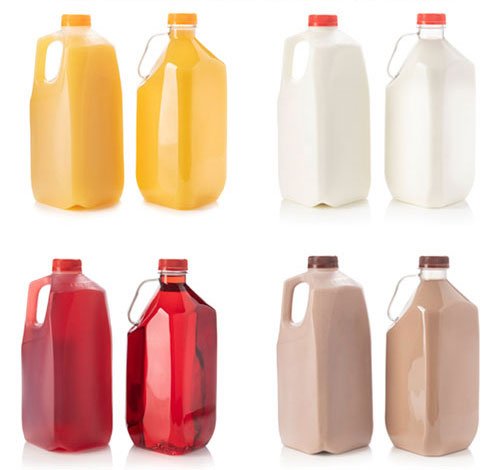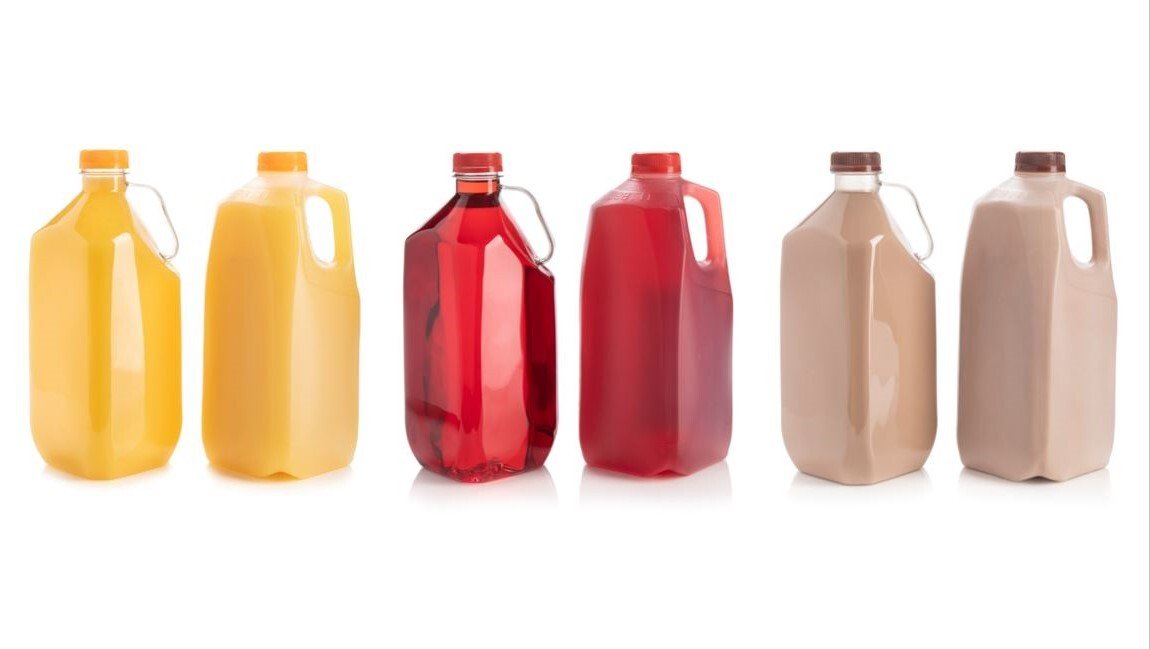Hopefully by now you’ve heard of BottleOne’s revolutionary large format PET bottle with an integrated PET handle. The innovative technology incorporated into each bottle is shaking up the dairy industry and other large format, multi-serve packages. It’s also raising questions about the inefficiencies in HDPE, which can be found across the entire supply chain.
In the Dairy industry, the standard HDPE bottle is 56 grams. The BottleOne PET bottle is 84 grams. Doesn’t a heavier bottle automatically mean higher costs? Not exactly…
The BottleOne PET Bottle vs. HDPE Jugs
The BottleOne PET bottle has the structural durability to survive without the help of crates or boxes – eliminating their need entirely. That additional durability requires a heavier bottle, making it impossible to use a simple weight comparison between BottleOne and HDPE jugs without factoring in the crate or cardboard.
However, if you want to simply look at the cost of resin as the only meaningful measuring stick, let’s do a very basic analysis and denominate it in terms of grams of plastic.
Though retail customers and end users don’t buy empty bottles, for the purpose of this evaluation, we will only focus on evaluating empty bottles delivered to the filler because once you get passed the filler, the economics flip (decisively and quickly) in favor of PET.
Let’s assume the current price of PET resin is $0.454 per pound. Since there are 454 grams in every pound, the simple math based upon this resin cost means 10 grams translates to a cost of $0.01 (one penny).
Therefore, we can conclude that every penny you save is worth 10 grams of weight in the bottle.
There are also enumerable cost savings to consider with BottleOne throughout the supply chain. Not only are these cost savings attainable, but reinvestment economics become very attractive as well. BottleOne’s engineering partner can help you define those savings.
Let’s quickly evaluate the impact of just two simple examples to determine the initial cost (weight) difference.
Bagging and De-Bagging HDPE Bottles
On average, one person can de-bag a 6 x 8 bag of HDPE bottles in about 30 seconds. This is a rate of about 120 bundles per hour. This means one person is de-bagging 48 bottles/bag x 120 bags/hour or 5,760 bottles per hour.
If that person’s pay scale is $20 per hour, and you carry a fringe rate of 40%, this is costing you nearly $0.005 (half a penny) per bottle. Add to that the cost of the bag at about $0.48 per bag. That adds another penny per bottle to the cost of your operation.
If we assume that the cost to move the bottles into a warehouse and then bring them back adds another $0.005 (half a penny) at least, then we have just added about 2 cents to each HDPE bottle. With BottleOne, all of this cost goes away. That would be the equivalent of saving 20 grams of resin per PET bottle. All of a sudden that 28 gram difference shrinks to an 8 gram difference.
The Economics of Crates
In the current operation, crates are essential in HDPE packaging since the HDPE bottle has no significant top load capability. Crates are entirely unnecessary with the BottleOne PET bottle. In most dairies, crate float management is a departmental operation, requiring a staff of people.
The cost of labor, storage trailers, floor space, and sanitizing is easily calculated. Those costs must be added to the empty bottle cost to be on a level playing field with BottleOne since BottleOne doesn’t require crates, sanitation, warehousing, or float management.
In addition to the crates, the trucks also need to be sanitized. This built-in inefficiency of HDPE operations is eliminated with PET. Let’s set aside the calculation of those savings for another time, but suffice to say they are significant.
Bottlers pay on average $2.75 for a four-gallon crate. They are engineered for 200 trips. They average about 25 trips before they fall out of the system due to pilferage, damage or loss. For HDPE, the cost of the bottle and the shipping protection (crate) is separately accounted for. With a BottleOne PET bottle, the container comes with the structural benefits of crates included.
So figure $0.10 (a dime) per crate, per trip ($2.75/25). Since a crate will hold four (4) gallon containers, this means the raw cost of the crate alone adds $0.025 (2.5 cents) to every gallon bottle being shipped each time it goes out the door full of milk.
If we conservatively add another penny per bottle to retrieve the crate, wash it and make it available again, the actual cost of using crates becomes $0.035 (3.5 cents) per bottle.
With BottleOne, all these costs go away. This would be the equivalent of saving 35 grams of resin per PET bottle. Add this to the 20 grams of savings from eliminating the bagging and de-bagging of HDPE bottles which we already mentioned.
Based on these two areas of savings alone, BottleOne PET bottles will save you the cost equivalent of 55 grams of HDPE resin.

Hopefully now you can see that BottleOne, based upon the cost of resin, is a far less expensive option. And, we can show you dozens of other areas of savings available to you.
Because dairy processors have not had a viable alternative to the HDPE bottle for the last 55 years, these savings opportunities are considered “the cost of doing business” on a 20th century P&L. You will not find those costs on a 21st century BottleOne P&L.
Dairies around the country run PET single serve lines. They could have installed HDPE small bottle lines, but the efficiency, consumer acceptance, and economic advantages of PET are overwhelming in single serve. We have ample proof that they are equally attractive in multi-serve sizes.
How can you not afford to make the change to BottleOne?
It’s easy to understand the reluctance to change from a package that has been around for 55 years, but it is time. COVID-19 has brought the year 2030 forward to 2020. We need better performing, more sustainable packaging, like BottleOne, for consumer products.
It’s time for BottleOne. Most adopters of BottleOne will roll out the technology on a line-by-line basis. It will take some time for full conversion, so the conversion will seem incremental. The BottleOne P&L and consumer acceptance will be much more convincing than I can be, and they both have loud voices. Based upon bottom line projections I have seen, I’m not sure dairies can afford to stay in HDPE much longer.
If you have questions, please reach out to us in the comment section below. We’ll be sure to answer them. As always, thank you for interest in BottleOne and for visiting our blog.
Let us show you how BottleOne will improve your operating efficiencies and increase your profitability
BottleOne is an affordable large capacity, standard grade PET bottle with an integrated PET handle. BottleOne is designed to dramatically impact your supply chain. Let us introduce you to this 21st century operating model.


0 Comments